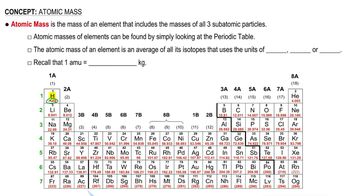Suppose a scientist repeats the Millikan oil-drop experiment but reports the charges on the drops using an unusual (and imaginary) unit called the warmomb (wa). The scientist obtains the following data for four of the drops: Droplet Calculated Charge (wa) A 3.84⨉10−8 B 4.80⨉10−8 C 2.88⨉10−8 D 8.64⨉10−8 (d) What is the conversion factor between warmombs and coulombs?
Ch.2 - Atoms, Molecules, and Ions
Chapter 2, Problem 88c
The natural abundance of 3He is 0.000137%. (c) Based on your answer to part (b), what would need to be the precision of a mass spectrometer that is able to differentiate between peaks that are due to 3He+ and 3H+?
 Verified step by step guidance
Verified step by step guidance1
Step 1: Understand the problem. The question is asking for the precision of a mass spectrometer that can differentiate between ^3He+ and ^3H+. The precision of a mass spectrometer is determined by its ability to distinguish between two ions with very close mass-to-charge ratios.
Step 2: Recall that the mass-to-charge ratio (m/z) is the key parameter that a mass spectrometer uses to differentiate between ions. For a singly charged ion, the m/z ratio is equal to the mass of the ion.
Step 3: Calculate the difference in mass between ^3He+ and ^3H+. The mass of ^3He is approximately 3 atomic mass units (amu) and the mass of ^3H (also known as tritium) is also approximately 3 amu. However, there is a slight difference between the two due to the difference in the number of neutrons.
Step 4: The precision of the mass spectrometer must be greater than this difference in mass in order to differentiate between the two ions. This means that the mass spectrometer must be able to detect differences in mass that are less than the difference between the mass of ^3He and ^3H.
Step 5: Express the required precision as a percentage of the mass of the ions. This is typically how precision is reported for mass spectrometers.

Verified video answer for a similar problem:
This video solution was recommended by our tutors as helpful for the problem above.
Video duration:
6mWas this helpful?
Key Concepts
Here are the essential concepts you must grasp in order to answer the question correctly.
Mass Spectrometry
Mass spectrometry is an analytical technique used to measure the mass-to-charge ratio of ions. It allows for the identification and quantification of different isotopes and molecules in a sample. The precision of a mass spectrometer is crucial for distinguishing between ions with very similar mass, such as isotopes of hydrogen, which is essential in this context.
Recommended video:
Guided course

Atomic Mass
Isotopes and Natural Abundance
Isotopes are variants of a chemical element that have the same number of protons but different numbers of neutrons, resulting in different masses. The natural abundance of an isotope refers to its relative occurrence in nature, expressed as a percentage. Understanding the natural abundance of isotopes like
3He and
3H is important for determining the required precision in mass spectrometry to differentiate between them.
Recommended video:
Guided course

Isotopes
Resolution in Mass Spectrometry
Resolution in mass spectrometry refers to the ability of the instrument to distinguish between two closely spaced mass peaks. Higher resolution allows for better differentiation between ions with similar masses, which is critical when analyzing isotopes with small differences in mass. The required resolution can be calculated based on the natural abundance and the expected peak separation of the isotopes in question.
Recommended video:
Guided course

Atomic Mass
Related Practice
Textbook Question
Textbook Question
The natural abundance of 3He is 0.000137%. (a) How many protons, neutrons, and electrons are in an atom of 3He?
2
views
Textbook Question
The natural abundance of 3He is 0.000137%. (b) Based on the sum of the masses of their subatomic particles, which is expected to be more massive, an atom of 3He or an atom of 3H (which is also called tritium)?
2
views
Textbook Question
A cube of gold that is 1.00 cm on a side has a mass of 19.3 g. A single gold atom has a mass of 197.0 u. (a) How many gold atoms are in the cube?
Textbook Question
A cube of gold that is 1.00 cm on a side has a mass of 19.3 g. A single gold atom has a mass of 197.0 u. (b) From the information given, estimate the diameter in Å of a single gold atom.
1
views
